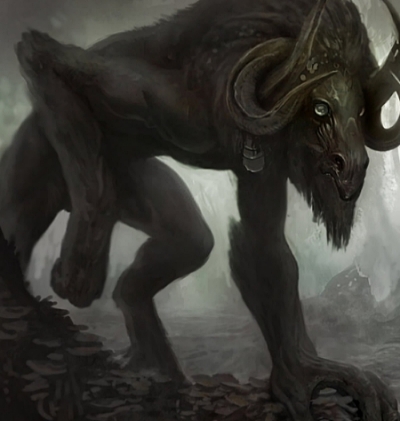Nehren

Frequency: Nehren are common beasts of burden and companions to the people of Warrick, especially those of Henry Warrick's bloodline; outside of Warrick they can be found in most parts of Rynmere. They only very rarely travel away from the island Rynmere itself.
Toxicity/Hazard: Nehren are not toxic in any way and are generally nonhazardous. They don't have a fighting temperament, and can't reliably be trained to attack. These are docile creatures, simply devoted to their masters.
Appearance: Nehren are gentle giants, huge and threatening in appearance but of sweet disposition. They are extremely strong and muscled, their bodies something of a cross between man and beast, with characteristics of goats or oxen. At the same time --perhaps due to their bumbling gait-- the nehren in a way are reminiscent of bears. They have strong, wide shoulders that, when full grown, are easily the width of a man's wingspan outstretched, and nehren stand at the shoulder just a hair taller than the average person. They are extremely big and well-suited to hard labor, like farm work or pulling carts or wagons. In a pinch, a nehr can be used as a mount, though they are slower than horses; however, when used as draft animals they tend to pull harder than the average horse or ox, making up for their slowness. They are often trusted to pull even the heaviest loads.
Nehren walk on all fours, though can stand on two feet like a bear; when standing, they reach a head-height of fifteen feet. They are extremely heavy, weighing in at half a ton, and are covered in a fine greyish coat of hair, more like a fuzz than anything, though males often have darker, heavier manes around their heads, shoulders, and bellies. They have large, curled horns, long floppy ears, hand-like paws in the front (though they lack a true thumb) and hooves on their back legs, with very little neck between head and shoulders.
Properties/Abilities: Nehren are strong, capable laborers, good for pulling a plow, uprooting stubborn stumps, digging trenches, and any and all other indelicate outside work; thanks to their hand-like front paws, they are also able to grip and lift things in a way that most animals could not. Though of little intelligence, they can be readily trained to perform just about any unrefined manual task.
It is when nehren come together in groups that they can achieve just about anything. These beasts of burden have a sort of 'additive quality' when they are near each other, tending to think alike, and thus able to work with one another to combine their efforts; the more nehren gathered, the stronger --and more capable-- they become. It is said that Hunter's Pass was created by the fallen body of a slain giant; in truth the pass was forged through the mountains by a large herd of nehren, commanded by the original Hunter.
Hunters are the descendants of Henry Warrick-- one of the seven founders of Rynmere. Nehren, for whatever reason, seem to gravitate towards these people through some sort of connection created long past. Though good workers for anyone, nehren seem to adore the Warrick bloodline especially. The bond between a Warrick and their nehr is one of true trust, loyalty, and devotion. Warrick nehren love their masters unconditionally. It is these nehren that tend, more than the rest, to be treated as companions or mounts, rather than mere beasts of burden.
History: Like most everything on Rynmere, not much is known of the nehren's origins, though some have speculated that at one point they were more human than the creatures known today.
Lifespan and Development: Nehren tend to live about 15-odd arcs (years), though some have lived as long as twenty. Most of their growth is in their first four years; after that, they usually have reached their full-grown size. There is no size or strength dichotomy between male and female nehren, and, though unusual, some females even grow horns, though theirs tend to be shorter and straighter, instead of curled forward near the face. It is thought that the horns of nehren are for the most part ornamental, used only for gentle head-bumps and to determine a creature's attractiveness as a mate.
Nehren tend to mate in the early spring, just after Cylus, and gestate for around 5 and a half months, birthing midway through Ymiden. They can have up to four calves per pregnancy, though the usual is one or two. When they are newborn, nehren weigh only a few pounds. They grow quickly, and like many animals are able to see, walk, and follow their mothers within a few short days. A nehren will stay with its mother for one to two years unless part of a breeding program; bred nehren can be sold at 8 months, at the earliest. Young nehren separated from their mothers must have a surrogate parent to care for them, someone they spend most --if not all-- of their time with, or they will become severely depressed.
Most nehren retire from labor at the age of twelve, though these animals are so amiable that even in their later years they make excellent pets, especially as nannies for small children. There has never been an incident reported of a nehr turning on its adopted family; even if abused, they're much more likely to become sad and listless than to protect themselves.
Diet: Nehren mostly subsist on vegetable matter. Hay and other sweet or starchy grasses, grains, tubers, and roots are the majority of their diet. However, they can supplement their food with insects and even worms and snails if plant matter is lacking; they also appreciate the occasional table scrap as a treat. Some nehren must be trained not to dig in the ground in a search for food, as letting a nehr develop bad habits could end up quite poorly, with the nehr destroying a person's entire property.
When eating, nehren pick up their food with their hands to bring to their mouths, much like people, or rats. Their teeth are dull and square, good for grinding, like a cow's. They cannot digest much meat or dairy, though they can digest cellulose and other tough fibers.
Vocalizations: Nehren are quiet creatures who hardly ever make noise. When they do it is usually in distress or as a sign of affection. They have a limited range of vocalizations, usually soft moos, grunts, deep exhales called chuffs, and whickers.
Other Information: People who ride nehren usually ride bareback, right up behind the shoulders. Nehren have occasionally been known to climb trees and other obstacles, and perhaps make better mounts than horses for rough mountain terrain. However, these large creatures are too dense to properly swim, and as such cannot be expected to ford lakes or other deep bodies of water. Their ability to cross a river or stream depends entirely on how deep the water is.
Credit: Quio

